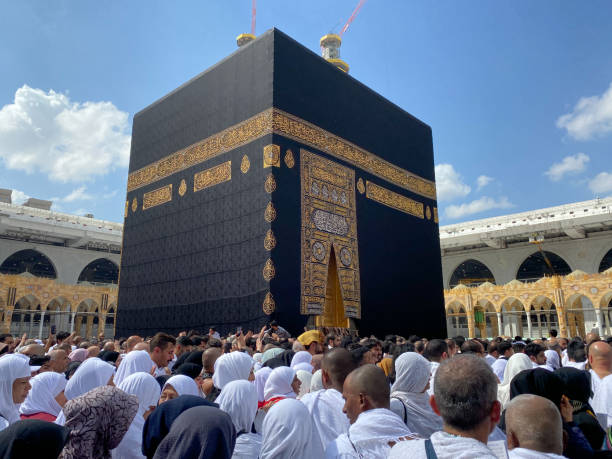
Menu


Umrah is also known as the ‘minor Hajj’. It is a Sunnah and can be performed anytime during the year except for the five days of Hajj, i.e. from 9th Zul Hijjah to 13th Zul Hijjah. In these five days, it is makrooh tahreemi to perform Umrah.
“The reward of deeds depends on the intentions”. (Bukhaari)
The intention must be to please Allah ta‘aalaa exclusively, hopeful of earning rewards only from Allah ta‘aalaa, the Creator, believing in what has been promised by Allah ta‘aalaa through our beloved Prophet sallallahu alayhi wasallam and performing the act according to the way shown by him. Hence, this must always be borne in our minds.
3 Sa‘ee between Safaa and Marwah.
4 Halaq or Qasr.
Labbayk, Allaahumma labbayk. Labbayka laa shareeka laka labbayk. Innal hamda wanni‘mata laka wal mulk. Laa shareeka lak.
“Here I am at Your Service, O Lord, here I am. Here I am, no partner do You have, here I am. Truly, the Praise and the Favour is Yours, and the Sovereignty. No partner do You have”.
Men should recite these words loudly, and the women silently. Now, read durood shareef and make du‘aa for as long as you can.
Ihraam becomes complete on
Making niyyah
Recitation of talbiyah.
Now you must refrain from certain acts which become forbidden.
1. On (or prior to) reaching Meeqaat, perform ghusl if possible, otherwise wudhoo. Thereafter, put on the clothes of ihraam, preferably of a white colour – two sheets, one to cover the lower part of the body and the other for the upper part of the body. At this moment, men folk may apply ‘itr (perfume). The women should keep all their body covered in their normal clothing, except the face.
allaahumma innee ureedul umrata fayassirhaa lee wataqabbalhaa minnee
“O Allah, I intend to perform Umrah. Make it easy for me and accept it from me”.
Then read the following du‘aa (known as talbiyah) three times:
Labbayk, Allaahumma labbayk. Labbayka laa shareeka laka labbayk. Innal hamda wanni‘mata laka wal mulk. Laa shareeka lak.
“Here I am at Your Service, O Lord, here I am. Here I am, no partner do You have, here I am. Truly, the Praise and the Favour is Yours, and the Sovereignty. No partner do You have”.
Men should recite these words loudly, and the women silently. Now, read durood shareef and make du‘aa for as long as you can.
Ihraam becomes complete on
Now you must refrain from certain acts which become forbidden.
Now you must perform tawaaf which is fardh in Umrah. During tawaaf, engage yourself in du‘aa and remembrance of Allah ta‘aalaa. The recital of the holy Qur’aan is also permissible. Be mindful that you do not raise your voice as this will cause disturbance to others performing tawaaf.
fardh) to perform tawaaf.
bismillaahi allaahu akbar walillaahil hamd “In the Name of Allah, Allah is the Greatest, and all Praise is for Allah”.
bismillaahi allaahu akbar
“In the Name of Allah, Allah is the Greatest”.
and kiss them. This is known as istilaam. It should be performed at the end of every round standing on the black/brown line facing Al Hajarul Aswad.
kaafiroon’ in the first raka‘at and ‘Qul huwallaahu
ahad’ in the second raka‘at. Thereafter engage yourself in du‘aa.
NOTE: If you cannot find a place at Maqaami Ibraaheem, it is sufficient to perform the two raka‘at anywhere within the sacred Masjid.
NOTE: If you wish, you can go to Multazam prior to going to the well of Zamzam.
Mas’alah: The kissing of Al Hajarul Aswad is a Sunnah, while safeguarding the dignity of Muslims is fardh. A fardh cannot be sacrificed for a Sunnah, because Allah ta‘aalaa does not accept a Sunnah which violates a fardh. Some pilgrims ignore this fact when they harm others in their zeal to kiss Al Hajarul Aswad, which is merely a Sunnah. To harm any believer in performing this Sunnah is haraam (prohibited). How is it possible to carry out a Sunnah observance while performing a haraam
deed? Therefore, when the area is crowded it is sufficient to raise the hands saying ‘Bismillaahi allaahu akbar’ and to continue to move into the flow of the people. Inshaa’allah, Allah will grant you His Mercy and will increase your reward.
Mas’alah: There are no prescribed du‘aa for tawaaf. One should rather make du‘aa for the fulfilment of one’s needs of both – this world and the hereafter.
Mas’alah: Hateem is part of Ka‘bah. Therefore, one must go around the Hateem to complete the tawaaf.
Mas’alah: It is Sunnah for men to perform the first three rounds with ramal.
Mas’alah: Idhtibaa is for men only, and it is Sunnah ONLY during tawaaf. Discontinue the idhtibaa after completing the seven rounds of tawaaf.
Mas’alah:During tawaaf when you come to Al Ruknul Yamaani, merely touch it with both hands or the right hand. It is not Sunnah to kiss or raise hands at this corner.
Mas’alah: Between Al Ruknul Yamaani and Al Hajarul Aswad it is Sunnah to recite:
Rabbanaa aatinaa fid dunyaa hasanataw
wafil aakhirati hasanataw waqinaa ‘azaaban naar
“O Allah, grant us goodness in this world, and goodness in the hereafter, and save us from the punishment of the fire”.
allaahu akbar laa ilaaha illallaah
“Allah is the Greatest, there is no deity except Allah”.
between the green lights too.
4. On Marwah too, you should go upto such a place from where the Ka‘bah is visible. The same actions must be performed as on Safaa. This is one round.
NOTE: Ka‘bah is not visible from Marwah, therefore climb Marwah and estimate the direction of Ka‘bah.
5. From Marwah proceed towards Safaa in the same manner as described above. On reaching Safaa you have completed the second round.
6. Complete seven rounds in this manner. The final round will end at Marwah.
7. At this stage it is mustahab to perform two raka‘at in Al Masjidul Haraam.
Mas’alah: During sa‘ee you are not restricted to any specific du‘aa. You may make any du‘aa you wish. However, it is Sunnah to recite:
rabbighfir warham antal a‘azzul akram.
“O my Lord, forgive and have mercy. You are the most Majestic, the most Generous”.
HALAQ
After completing the sa‘ee, you must shave your head or trim the hair of the entire head in such a manner that you trim at least one inch of each hair. Shaving the head is more virtuous.
The women should trim slightly more than one inch from the end of their plait.
After shaving or trimming the hair, the rituals of Umrah have ended and all restrictions imposed due to the ihraam will be lifted.
May Allah ta‘aalaa accept your Umrah and bestow you with its blessings.
Yahyaa Ibne Husayn reported on the authority of his grandfather that Rasoolullah sallallahu alayhi wasallam on the occasion of the Farewell Hajj made du‘aa thrice for those who shave their heads and once only for those who trim their hair.
Muslim
“Besides Makkah there is no city on the surface of the earth where Allah multiplies one virtue by a hundred thousand times”.
“I would much rather prefer to commit seventy sins at Rukyah than to commit one sin in Makkah”.
NOTE: Rukyah is a place outside Makkah.
NOTE: The offering of two raka‘at at Maqaami Ibraaheem is essential even after nafl tawaaf.
4. Visit Jannatul Ma‘alaa (the graveyard of Makkah) and other sacred places of Makkah.
5. Utilise your time in doing good. Remember! You may not get this opportunity again.
When a person sets forth to perform Hajj or Umrah and passes away en route, he shall not be brought (before Allah) for judgement, nor will he have to give account. It shall be said to him: ‘Enter into Jannah.’
Targheeb
Ibne Abbaas radhiyallahu anhu says that Rasoolullah sallallahu alayhi wasallam addressed Makkah, “What a beautiful town you are and most beloved to me. If my people did not expel me from you I would not have stayed elsewhere.”
Tirmizi
Al Hajarul Aswad The stone set in the southeast corner of the Ka‘bah. It is set about 4.5 feet from the ground in a silver casing.
Al Masjidul Haraam The sacred Masjid in Makkah. Al Ruknul Yamaani The corner of the Ka‘bah preceding the corner in which lies Al Hajarul Aswad
Baytullaah See Ka‘bah. Deen The religion Islaam. Du‘aa Supplication, prayer.
Durood Shareef Salutations upon the holy Prophet
sallallahu alayhi wasallam.
Fardh Obligatory.
Ghusl Bath.
Halaq To have the head shaved.
Haraam Forbidden.
Hateem The semi-circle outside Ka‘bah.
Idhtibaa To put one end of your cloth (covering the top part of your body) on the left shoulder, and take the other end from below the right armpit, throwing it over the chest onto the left shoulder, thus leaving the right arm and shoulder entirely exposed.
Ihraam To put on the special dress (i.e. two unsewn sheets of cloth, preferably new and of white colour). Thereafter, to make the niyyah of Umrah and recite talbiyah. It has been named ihraam because after performing these three actions,
certain permissible acts become prohibited (haraam).
Women enter into the state of ihraam without putting on the special clothing. It is for men only.
Istighfaar To ask forgiveness from Allah ta‘aalaa.
Istilaam See Page 12.
Ka‘bah The Sacred House of Allah ta‘aalaa which stands in the centre of the sacred Mosque of Makkah. Makrooh Tahreemi Prohibited.
Maqaami Ibraaheem A few meters away from the door of Ka‘bah stands a small kiosk (gold in colour) which contains a stone with a figurative indentation of a footprint of Prophet Ibraaheem alayhis salaam. This footprint was impressed into the stone during the building of Ka‘bah.
Marwah See Safaa.
Mas‘aa See Safaa and Marwah.
Meeqaat It is the place which is fixed for putting on ihraam or in other words, it is the boundary beyond which a person intending to go to Makkah cannot go without ihraam. (Jeddah is beyond this boundary, therefore one must put on ihraam before reaching Jeddah).
Miswaak A stick used for cleaning teeth.
Multazam It is the part of the Ka‘bah situated between Al Hajarul Aswad and the door of the Ka‘bah. It comes from the Arabic word meaning to become attached, and perhaps it is so called because this is the section of the Ka‘bah where a person should attach his body.
Mustahab Desirable.
Nafl Optional.
Niyyah Intention.
Ramal To walk with quick short steps; lifting the legs forcefully; chest out; and moving the shoulders simultaneously.
Sa‘ee To walk between Safaa and Marwah seven times. It is performed walking, except for a portion in the middle, today marked by green lights, where the pace is quickened.
Safaa and Marwah Two small hills, in Makkah. The remains of both hills are enclosed within the sacred Mosque. The two hills are separated by a distance of 394m/1247ft which is called Mas‘aa. This distance is walked, and in part run, seven times by those performing Hajj or Umrah.
Sunnah The way shown by the holy Prophet sallallahu alayhi wasallam – physically or verbally.
Talbiyah See Pages 5 & 6.
Tawaaf The ritual circumambulation of the Ka‘bah, starting from Al Hajarul Aswad. This is done anti- clockwise with the Ka‘bah on the left hand side, seven times.
Umrah To enter into ihraam from Meeqaat or (for those people already in Makkah) from Masjid Tan‘eem, perform tawaaf of Ka‘bah, walk between Safaa and Marwah and shave the head. Its rituals take place entirely in Makkah.
Waajib Incumbent, less than fardh.
Wudhoo Ablution.
Zamzam The blessed water in Makkah.
We at Salah Travels work closely with all our customers to give them a memorable Umrah experience. We hope that the above guidelines will help you prepare for an excellent journey full of reflection and awakening.
Discover Cheap Umrah Packages from USA with Salah Travels
Salah Travel is one of the world’s leading Hajj and Umrah experts headquartered in Chicago illinois, USA.